Vetsulin
vetsulin (porcine insulin zinc suspension)
FULL PRESCRIBING INFORMATION: CONTENTS*
- CAUTION
- VETSULIN DESCRIPTION
- INDICATION
- VETSULIN DOSAGE AND ADMINISTRATION
- VETSULIN CONTRAINDICATIONS
- WARNINGS
- PRECAUTIONS
- VETSULIN ADVERSE REACTIONS
- GENERAL PHARMACOLOGY
- EFFECTIVENESS
- HOW SUPPLIED
- STORAGE CONDITIONS
- PRINCIPAL DISPLAY PANEL - 10 mL Multi-Dose Vial Carton
FULL PRESCRIBING INFORMATION
NADA 141-236, Approved by FDA
136855 R6
CAUTION
Federal law restricts this drug to use by or on the order of a licensed veterinarian.
VETSULIN DESCRIPTION
vetsulin® is a sterile aqueous zinc suspension of purified porcine insulin.
| Each mL contains: | purified porcine insulin 40 IU (35% amorphous and 65% crystalline) Zinc (as chloride) 0.08 mg Sodium acetate trihydrate 1.36 mg Sodium chloride 7.0 mg Methylparaben (preservative) 1.0 mg pH is adjusted with hydrochloric acid and/or sodium hydroxide. |
INDICATION
vetsulin® (porcine insulin zinc suspension) is indicated for the reduction of hyperglycemia and hyperglycemia-associated clinical signs in dogs and cats with diabetes mellitus.
VETSULIN DOSAGE AND ADMINISTRATION
FOR SUBCUTANEOUS INJECTION IN DOGS AND CATS ONLY
Vials: USE OF A SYRINGE OTHER THAN A U-40 SYRINGE WILL RESULT IN INCORRECT DOSING.
Shake the vial thoroughly until a homogeneous, uniformly milky suspension is obtained. Foam on the surface of the suspension formed during shaking should be allowed to disperse before the product is used and, if required, the product should be gently mixed to maintain a homogeneous, uniformly milky suspension before use. Clumps or white particles can form in insulin suspensions: do not use the product if visible clumps or white particles persist after shaking thoroughly.
Cartridges: VETSULIN® CARTRIDGES SHOULD BE USED EXCLUSIVELY WITH VETPEN™ AND 29G/12 MM PEN NEEDLES. Prior to loading vetsulin® cartridges, shake the cartridge until a homogeneous, uniformly milky suspension is obtained. Clumps or white particles can form in insulin suspensions: do not use the product if visible clumps or white particles persist after shaking. The detailed instructions for use provided with VetPen™ should be strictly followed.
The injection should be administered subcutaneously, 2 to 5 cm (3/4 to 2 in) from the dorsal midline, varying from behind the scapulae to the mid-lumbar region and alternating sides.
Always provide the Owner Information Sheet with each prescription.
Dogs
The initial recommended vetsulin® dose is 0.5 IU insulin/kg body weight. Initially, this dose should be given once daily concurrently with, or right after a meal.
Twice daily therapy should be initiated if the duration of insulin action is determined to be inadequate. If twice daily treatment is initiated, the two doses should each be 25% less than the once daily dose required to attain an acceptable nadir. For example, if a dog receiving 20 units of vetsulin® once daily has an acceptable nadir but inadequate duration of activity, the vetsulin® dose should be changed to 15 units twice daily.
The veterinarian should re-evaluate the dog at appropriate intervals and adjust the dose based on clinical signs, urinalysis results, and glucose curve values until adequate glycemic control has been attained. Further adjustments in dosage may be necessary with changes in the dog's diet, body weight, or concomitant medication, or if the dog develops concurrent infection, inflammation, neoplasia, or an additional endocrine or other medical disorder.
Cats
The initial recommended dose in cats is 1 to 2 IU per injection. The injections should be given twice daily at approximately 12 hour intervals. For cats fed twice daily, the injections should be given concurrently with, or right after each meal. For cats fed ad libitum, no change in feeding schedule is needed.
The veterinarian should re-evaluate the cat at appropriate intervals and adjust the dose based on clinical signs, urinalysis results, and glucose curve values until adequate glycemic control has been attained. Further adjustments in dosage may be necessary with changes in the cat's diet, body weight, or concomitant medication, or if the cat develops concurrent infection, inflammation, neoplasia, or an additional endocrine or other medical disorder.
VETSULIN CONTRAINDICATIONS
Dogs and cats known to have a systemic allergy to pork or pork products should not be treated with vetsulin®. vetsulin® is contraindicated during periods of hypoglycemia.
WARNINGS
User Safety: For use in animals only. Keep out of the reach of children. Avoid contact with eyes. In case of contact, immediately flush eyes with copious amounts of water for 15 minutes. Accidental injection may cause clinical hypoglycemia. In case of accidental injection, seek medical attention immediately. Exposure to product may induce a local or systemic allergic reaction in sensitized individuals.
Animal Safety: Owners should be advised to observe for signs of hypoglycemia (see Owner Information Sheet). Use of this product, even at established doses, has been associated with hypoglycemia. An animal with signs of hypoglycemia should be treated immediately. Glucose should be given orally or intravenously as dictated by clinical signs. Insulin should be temporarily withheld and, subsequently, the dosage should be adjusted, if indicated. Any change in insulin should be made cautiously and only under a veterinarian's supervision. Changes in insulin strength, manufacturer, type, species (animal, human) or method of manufacture (rDNA versus animal-source insulin) may result in the need for a change in dosage.
Appropriate diagnostic tests should be performed to rule out endocrinopathies in pets that are difficult to regulate (e.g., hyperadrenocorticism in dogs and hyperthyroidism in cats).
PRECAUTIONS
Animals presenting with severe ketoacidosis, anorexia, lethargy, and/or vomiting should be stabilized with short-acting insulin and appropriate supportive therapy until their condition is stabilized. As with all insulin products, careful patient monitoring for hypoglycemia and hyperglycemia are essential to attain and maintain adequate glycemic control and prevent associated complications. Overdosage can result in profound hypoglycemia and death. Progestogens, certain endocrinopathies, and glucocorticoids can have an antagonistic effect on insulin activity. Intact bitches should be ovariohysterectomized.
Progestogen and glucocorticoid use should be avoided.
Drug Interactions:
In the US clinical effectiveness studies, dogs and cats received various medications while being treated with vetsulin® including antimicrobials, antivirals, antifungals, antihistamines, analgesics, anesthetics/tranquilizers, diuretics, bronchodilators, corticosteroids (cats), NSAIDs, thyroid hormone supplementation, hyperthyroid medication (methimazole), internal and external parasiticides, anti-emetics, dermatological topical treatments and oral supplements, ophthalmic preparations containing antimicrobials and antiinflammatories, and various vaccines. No medication interactions were reported. This drug was not studied in dogs receiving corticosteroids.
Reproductive Safety: The safety and effectiveness of vetsulin® in breeding, pregnant, and lactating dogs and cats has not been evaluated.
Use in puppies and kittens: The safety and effectiveness of vetsulin® in puppies and kittens has not been evaluated.
VETSULIN ADVERSE REACTIONS
Dogs
In the field effectiveness and safety study, 66 dogs were treated with vetsulin®. Sixty-two dogs were included in the assessment of safety. Hypoglycemia (defined as blood glucose < 50 mg/dL) with or without associated clinical signs occurred in 35.5% (22/62) of the dogs at various times during the study. Clinical signs of hypoglycemia were generally mild in nature (described as weakness, lethargy, stumbling, falling down, and/or depression). Disorientation and collapse were reported less frequently and occurred in 16.1% (10/62) of the dogs. Two dogs had a seizure and one dog died during the seizure. Although never confirmed, the presumptive diagnosis was hypoglycemia-induced seizures. In the rest of the dogs, hypoglycemia resolved with appropriate therapy and adjustments in insulin dosage. Seven owners recorded the following observations about the injection site on the home monitoring forms: swollen, painful, sore, and a bleb under the skin.
The following clinical observations occurred in the field study following treatment with vetsulin® and may be directly attributed to the drug or may be secondary to the diabetic state or other underlying conditions in the dogs: hematuria, vomiting, diarrhea, pancreatitis, non-specific hepatopathy/pancreatitis, development of cataracts, and urinary tract infections.
In a 21-day field safety and effectiveness study, 40 dogs, already well controlled on vetsulin®, were administered vetsulin® using a VetPen™ insulin pen loaded with a pre-filled 2.7 mL vetsulin® cartridge and 29 gauge/12 mm pen needles. All dogs enrolled in the study were evaluated for safety. Loss of diabetic control was reported in 10 dogs, 3 of which were withdrawn from the study. Four dogs' loss of control resolved after dose adjustment while still using the insulin pen. For the remaining 3 dogs, the loss of diabetic control was reported at the end of the study and outcome was not documented. Two dogs had injection site reactions: edema in one dog and two instances of crusting in another. Poor appetite and weight loss was reported in one dog.
Cats
In a field effectiveness and safety study, safety data was reported for 78 cats receiving vetsulin®. Hypoglycemia (defined as blood glucose < 50 mg/dL) was reported in 61 cats (88 total incidences). Fifteen of the occurrences (involving 13 cats) were associated with clinical signs described as lethargy, diarrhea, decreased appetite/anorexia, vomiting, and hypothermia. One cat had seizures following accidental overdosing by the owner and again during the subsequent dose adjustment period. The cat responded to supportive therapy and had no further hypoglycemic episodes. In all cases of hypoglycemia, the clinical signs resolved following symptomatic treatment and/or dose adjustment. Polyneuropathy was reported in 4 cats. Two injection site reactions were reported: one as a mildly thickened subcutaneous tissue reaction and the second as a mild bruising.
The following clinical observations occurred in the field study following treatment with vetsulin® and may be directly attributed to the drug or may be secondary to the diabetic state or other underlying conditions in the cats: vomiting, lethargy, diarrhea, decreased appetite/anorexia, pancreatitis, dermal events, respiratory disease, urinary tract disorder, renal disease, dehydration, weight loss, polydipsia, polyuria, behavioral change, and ocular discharge/conjunctivitis. In a smaller field effectiveness and safety study, 14 cats were treated with vetsulin®. Hypoglycemia was reported in 6 cats (8 total occurrences). Lethargy not associated with hypoglycemia was reported in 4 cats (6 total occurrences). The following clinical observations occurred in the field study following treatment with vetsulin® and may be directly attributed to the drug or may be secondary to the diabetic state or other underlying conditions in the cats: foul odor to stool, diarrhea, dull coat, rapid, shallow breathing, stiff gate in rear, gallop rhythm, and pruritus with alopecia.
During the 1998–2007 period, the following adverse events in 50 cats treated with porcine insulin zinc suspension were reported to Intervet International and Intervet Inc: Death, seizures, lack of effectiveness/dysregulation, hypoglycemia, allergic or skin reaction, lethargy, vomiting/diarrhea, injection pain, hyperthermia, nystagmus, PU/PD, and abnormal behavior.
In a 21-day field safety and effectiveness study, 36 cats, already well controlled on vetsulin®, were administered vetsulin® using a VetPen™ insulin pen loaded with a pre-filled 2.7 mL vetsulin® cartridge and 29 gauge/12 mm pen needles. Loss of diabetic control was reported in three cats all of which resolved after dose adjustment while still using the insulin pen. Hypoglycemia was reported in one cat. The cat recovered with supportive care and dose adjustment.
To report suspected adverse drug experiences, call Merck at 1-800-224-5318.
For additional information about adverse drug experience reporting for animal drugs, contact FDA at 1-888-FDA-VETS, or http://www.fda.gov/AnimalVeterinary/SafetyHealth
GENERAL PHARMACOLOGY
vetsulin® is a mixture of amorphous and crystalline insulin resulting in immediate and prolonged insulin activity. In dogs, vetsulin® may show two peaks of activity. In a laboratory study, 12 healthy adult Beagles were administered vetsulin® at a dose of 0.5 IU/kg. The onset of activity varied from 0.5 to 2 hours; the time to peak activity varied from 1 to 10 hours; and the duration of activity varied from 10 to 24 hours. In diabetic dogs, vetsulin® has two peaks of activity following subcutaneous administration (the first occurs at 2 to 6 hours and the second at 8 to 14 hours). The duration of activity varies between 14 and 24 hours.
In cats, vetsulin® has a single peak of activity. In a laboratory study, 12 healthy adult cats were administered vetsulin® at a dose of 0.5 IU/kg. The onset of activity varied from 0.5 to 2 hours; the time to peak activity varied from 2 to 6 hours; and the duration of activity varied from 8 to 24 hours. In diabetic cats, the peak activity following subcutaneous administration of vetsulin® occurs between 1.5 and 8 hours, and the duration of activity varies between 8 and 12 hours.
The peak(s) of activity, duration of activity, and dose required to adequately control diabetic signs vary between individuals and may vary in the same individual from day to day. The time ranges should only be considered as initial guidelines.
EFFECTIVENESS
Dogs
A total of 66 client-owned dogs were enrolled in and 53 completed the effectiveness and safety field study. The dogs completing the study included 22 breeds of purebred and various mixed breed dogs ranging in age from 4.8 to 14 years, and ranging in weight from 4.2 to 51.3 kg. Of the dogs completing the study, 25 were spayed females and 28 were male (21 neutered and 7 intact).
Dogs were started on vetsulin® at a dose of 1 IU/kg plus a body weight-dependent dose supplement once daily. The initial treatment time to reach acceptable glycemic control (Dose determination period) ranged from 5 to 151 days. Dogs were evaluated for treatment effectiveness three times at 30-day intervals (Study Period). The blood glucose curve means and mean nadirs were compared pre- and post-treatment to assess effectiveness. Glycemic control was considered adequate if an acceptable blood glucose curve was achieved (reduction in hyperglycemia and a nadir of 60 - 160 mg/dL), clinical signs of hyperglycemia (polyuria, polydipsia, and ketonuria) were improved, and hypoglycemia (blood glucose < 50 mg/dL) was avoided. The blood glucose curve mean was reduced from 370 mg/dL pre-treatment to 151 mg/dL, 185 mg/dL, and 184 mg/dL at the three treatment period evaluations. The blood glucose mean nadir was reduced from 315 mg/dL pre-treatment to 93 mg/dL, 120 mg/dL, and 119 mg/dL at the three treatment period evaluations. Sixty days after an adequate vetsulin® dose was initially established, 94%, 96% and 83% of study dogs experienced a reduction in polyuria, polydipsia, and ketonuria, respectively. Investigators reported adequate glycemic control an average of 81% of the time during the Study Period.
In a 21-day field safety and effectiveness study, 40 dogs, already well controlled on vetsulin®, were administered vetsulin® using a VetPen™ insulin pen loaded with a pre-filled 2.7 mL vetsulin® cartridge and 29 gauge/12 mm pen needles. Thirty-eight of 40 dogs were evaluated for effectiveness. Thirty-seven of the 38 owners (97.4 %) said they were able to learn how to use the pen. Thirty-five of the 38 owners (92.1 %) said the pen was well tolerated by the dogs. For 34 of the 38 dogs (89.5%), the investigators said that the diabetes was not negatively affected by the use of the pen.
Cats
A total of 85 client-owned cats (53 males and 25 females—all neutered) of various breeds were enrolled in a 60 day field effectiveness and safety study with continued use up to Day 180. Seven cats were removed from the study prior to the Day 7 evaluation. The remaining cats ranged in age from 3 to 17.5 years and in weight from 1.9 to 10.8 kg. Seventy-two cats completed the study to Day 60 and 66 cats completed to Day 180. The cats were started on vetsulin® at an initial dose of 1 to 2 IU insulin twice daily. Scheduled evaluations occurred at Days 7, 14, 30, 60, and 180. Dose adjustments were allowed at and between the evaluations. Effectiveness was based on blood glucose curve mean, blood glucose nadir and improvement in clinical signs. Blood glucose curve means decreased from 394 mg/dL on Day 0 to 217 mg/dL on Day 60. The mean blood glucose nadir decreased from 343 mg/dL on Day 0 to 146 mg/dL on Day 60. Fourteen client-owned cats (10 males and 4 females—all neutered) of various breeds were enrolled in a 60 day effectiveness and safety field study. The cats ranged in age from 5 to 14 years and in weight from 3.40 to 6.97 kg. Twelve cats completed the study. The cats were started on vetsulin® at an initial dose of 1 to 2 IU insulin twice daily. Scheduled evaluations occurred at Days 7, 14, 30, and 60. Dose adjustments were allowed at and between the evaluations. The blood glucose curve means decreased from 354 mg/dL on Day 0 to 162 mg/dL on Day 60. The mean blood glucose nadir decreased from 321 mg/dL on Day 0 to 99 mg/dL on Day 60. In a 21-day field safety and effectiveness study, 36 cats, already well controlled on vetsulin®, were administered vetsulin® using a VetPen™ insulin pen loaded with a pre-filled 2.7 mL vetsulin® cartridge and 29 gauge/12 mm pen needles. Thirty-six owners (100%) said they were able to learn how to use the pen. Thirty-four owners (94.4%) said the pen was well tolerated by the cats. For thirty-five cats (97.2%), the investigators said that the diabetes was not negatively affected by the use of the pen.
HOW SUPPLIED
vetsulin® is supplied as a sterile injectable suspension in multidose vials containing 10 mL of 40 IU/mL porcine insulin zinc suspension or in multidose cartridges containing 2.7 mL of 40 IU/mL porcine insulin zinc suspension. Vials are supplied in cartons of one, 10 mL vial. Cartridges are supplied in cartons of 10, 2.7 mL cartridges.
STORAGE CONDITIONS
Store in an upright position under refrigeration at 2°C to 8°C (36°F to 46°F). Do not freeze. Protect from light. The loaded VetPen™ can be stored on its side.
Use contents within 42 days of first puncture.
Additional information about vetsulin®, VetPen™, and diabetes mellitus can be found at www.vetsulin.com
| Distributed by: | Intervet Inc (d/b/a Merck Animal Health) Summit, NJ 07901 |
Made in Germany
09/13
Copyright © 2014 Intervet Inc., a subsidiary of Merck & Co., Inc. All rights reserved.
Intervet Inc. d/b/a Merck Animal Health, Summit, NJ 07901
vetsulin®
(porcine insulin zinc suspension)
Owner Information Sheet
vetsulin® Injectable Insulin (porcine insulin zinc suspension)
vetsulin® for reduction of hyperglycemia and hyperglycemia-associated
clinical signs in dogs and cats with diabetes mellitus
Generic name: U-40 Purified Porcine Insulin Zinc Suspension
This summary contains important information about vetsulin®. You should read this information before you start giving your pet vetsulin® and review it each time your prescription is refilled. This sheet is provided only as a summary and does not take the place of instructions from your veterinarian. Talk to your veterinarian if you do not understand this information or if you want to know more about vetsulin®.
What is vetsulin®?
vetsulin® is an aqueous suspension of porcine (pork) insulin. Insulin is a hormone produced by the pancreas (a large gland that lies near the stomach). This hormone is necessary for the body's correct use of food, especially sugar.
What is diabetes mellitus?
Diabetes mellitus (DM) occurs when a dog or a cat has inadequate levels of or an abnormal response to insulin. DM is common in middle age and older dogs and cats. Daily insulin injections are usually necessary to treat DM. vetsulin® may help your pet effectively use food, aid in maintaining an acceptable blood sugar (glucose) level, and reduce or eliminate clinical signs commonly seen with DM. Diabetes mellitus may cause some or all of these signs or changes:
- Excessive thirst (Polydipsia)
- Excessive urination (Polyuria)
- Excessive appetite (Polyphagia)
- Weight loss despite good appetite
- Glucose in the urine (Glycosuria)
- Ketones in the urine (Ketonuria)
- Cloudy eyes and vision loss (Diabetic cataracts: dogs)
- Weakness in back legs (Diabetic neuropathy: cats)
Untreated or improperly regulated diabetes may lead to changes in the acidity of the blood (diabetic ketoacidosis) with dehydration, vomiting, weakness, depression, coma, and death.
What kind of results can I expect when my pet is on vetsulin® for DM?
Although vetsulin® is not a cure for DM, it can help control or eliminate many of the complications associated with the disease (such as excessive thirst, urination, and weight loss) and prevent development of life threatening ketoacidosis.
- Response varies from animal to animal but can be quite dramatic.
- In most cases, improvement can be seen within a few days.
- In cats, treatment may lead to diabetes remission (insulin injections no longer required).
- If vetsulin® is discontinued or not given as directed, the signs of diabetes will likely return and life-threatening complications such as ketoacidosis may develop.
Who should not receive vetsulin®?
- Pets known to have a systemic allergy to pork or pork products.
- Pets that have stopped eating or have greatly decreased appetite (anorexia), are vomiting, show signs of extreme drowsiness or fatigue (lethargy) and/or show signs of severe ketoacidosis, should not receive vetsulin® until stabilized with appropriate supportive therapy.
- vetsulin® is for use in animals only. Keep out of reach of children. Seek medical attention immediately if accidental injection occurs.
What to tell/ask your veterinarian before using vetsulin®.
Talk to your veterinarian about:
- The signs of DM you have observed.
- What tests might be done before vetsulin® is prescribed.
- The importance of ovariohysterectomy (spaying), if your dog is an intact female.
- The importance of consistent daily injections, an appropriate and consistent diet, weight control, exercise, and home monitoring of your pet's condition.
- How often your pet may need to be examined by your veterinarian.
- The risks and benefits of using vetsulin®.
Tell your veterinarian if your pet has ever had the following medical problems
- Side effects when receiving other insulin products
- Digestive upset (vomiting and/or diarrhea)
- Liver disease
- Inflamed pancreas (Pancreatitis)
- Underactive thyroid (Hypothyroidism)
- Overactive thyroid (Hyperthyroidism)
- Cushing's Syndrome (Hyperadrenocorticism)
- Kidney disease
Tell your veterinarian about:
- Any medical problems or allergies that your pet has now or has had.
- All medicines that you are giving or plan to give your pet, including those you can get without a prescription.
What are the possible side effects that may occur during vetsulin® therapy?
The most common side effect experienced with vetsulin® therapy is hypoglycemia (low blood sugar). Hypoglycemia can be caused by:
- Giving too much insulin
- Missing or delaying food
- Change in food, diet, or amount fed
- Change (increase) in exercise
- Infection or illness
- Change in the body's need for insulin
- Diseases of the adrenal, pituitary, or thyroid gland, or progression of liver or kidney disease
- Interaction with other drugs (such as progestogen or glucocorticoids)
Signs of hypoglycemia may occur suddenly and can include
|
|
What do I do in case my pet shows signs of hypoglycemia?
- If your pet is unconscious or having a seizure, this is a medical emergency. Take your pet to your veterinarian immediately.
- If your pet is conscious, rub approximately 1 tablespoon of corn syrup or honey on your pet's gums. When it is able to swallow, give corn syrup or honey by mouth until your pet is alert enough to eat. Feed its usual meal and contact your veterinarian.
Other side effects that can be seen include loss of effectiveness and local or systemic allergic reactions. It is important to contact your veterinarian immediately if you think your pet has a medical problem or side effect from vetsulin® therapy. In particular, please contact your veterinarian if your pet shows any of the following:
- Excessive water consumption for more than 3 days
- Excess urination (including need to urinate at night for a pet that usually sleeps through the night or inappropriate urination in the house)
- Reduced or loss of appetite
- Weakness, seizures, or severe mental depression
- Behavioral change, muscle twitching, or anxiety
- Constipation, vomiting, or diarrhea
- Signs of a bladder infection (small, frequent urinations, straining, blood in the urine)
- Swelling of the head or neck
What else can I do to keep my pet's blood sugar stable?
- Your pet's diet should be consistent and appropriate. A nutritionally complete pet food should be fed in consistent amounts at the same times each day or, at the discretion of your veterinarian, be available continuously.
- "Treats" and changes in diet should generally be avoided unless recommended by your veterinarian.
- Your veterinarian will advise you on how much and when to feed your pet based on the response to vetsulin®.
- Your pet's exercise should remain consistent. Consult with your veterinarian if you expect a major change in activity.
- Develop a schedule with your veterinarian for regular evaluations of your pet's diabetes.
Can vetsulin® be used with other medications?
Progestogen (such as megestrol) and glucocorticoids (such as cortisone, prednisone, dexamethasone, triamcinolone) should be avoided during vetsulin® therapy. Progestogen, glucocorticoids, and certain endocrine diseases may counter the effect of insulin. Other medications may also interfere with your pet's response to insulin. Tell your veterinarian about all the medicines you have given your pet in the past, and any medicines that you are planning to give with vetsulin®. This should include other medicines that you can get without a prescription. Your veterinarian may want to check that all of your pet's medications can be given together.
What do I do in case my pet receives more than the prescribed amount of vetsulin®?
If your pet is given too much vetsulin®, severe (life-threatening) hypoglycemia (low blood sugar) can result. Contact your veterinarian immediately. If your veterinarian is not available, seek other veterinary advice at once. Your pet may need to be hospitalized for observation or treatment.
What do I do if my pet receives less than the prescribed dose, or I miss an injection?
- A missed or inadequate dose may cause temporary recurrence of signs (such as excess thirst and urination) but is not life threatening.
- Contact your veterinarian as soon as possible for advice on your pet's next dose.
- If you cannot reach your veterinarian and your pet is eating and acting normal, give your pet the usual dose at the next regularly scheduled injection time.
How to give vetsulin® to your pet
Doses of insulin are measured in units. U-40 insulin contains 40 units/mL (1 mL = 1 cc). vetsulin® is available in vials for use with U-40 syringes or in cartridges for use with the VetPen™ injection device. If you are using vials, refer to the section below. If you are using cartridges, refer to the VetPen™ instructions for use provided with the VetPen™.
Use vetsulin® with U-40 syringes only. Use of a syringe other than a U-40 syringe will result in incorrect dosing. A licensed veterinarian must prescribe vetsulin® for your pet, and it should be administered according to your veterinarian's instructions. Your veterinarian will determine the amount of insulin needed (based on the weight of your pet, clinical signs such as water consumption, and laboratory results), instruct you on proper storage and handling, show you how to draw the insulin from the bottle, and instruct you on how to administer the injection. Once you can do this correctly, your veterinarian will provide you with everything you need to care for your pet at home. vetsulin® should be administered with a U-40 insulin syringe according to the following instructions:
Preparing the Dose:
- Wash your hands
- Remove the vetsulin® bottle from the refrigerator and shake the vial thoroughly until a homogeneous, uniformly milky suspension is obtained. Foam on the surface of the suspension formed during shaking should be allowed to disperse before the product is used and, if required, the product should be gently mixed to maintain a homogeneous, uniformly milky suspension before use. If you see large particles floating in the suspension after thoroughly shaking, do not use the product and contact your veterinarian.
- Carefully remove the cap from the needle.
- Using a U-40 insulin syringe, pull the plunger back to draw air into the syringe to equal the vetsulin® dose.
- Insert the syringe needle into the bottle and inject the air into the bottle.
- Turn the bottle and syringe upside down. Making sure the tip of the needle is in the vetsulin®, withdraw the correct dose into the syringe.
- Before removing the needle from the bottle, check the syringe for any air bubbles. If bubbles are present, hold the syringe straight up and tap its side until the bubbles float to the top. Push them out with the plunger and withdraw the correct dose.
- Remove the needle from the bottle, being careful to not inject yourself.
Giving the injection:
- Injections should be given just under the skin (subcutaneously) 2-5cm (3/4-2 inches) from the midline of the back (middle of your pet's back running from tail to head), varying from just behind the shoulder blade to slightly in front of the hipbone.
- The injection site should be alternated between your pet's left and right side.
- Using your free hand, pinch up a fold of skin, insert the needle into the center of the fold as instructed by your veterinarian, and push the plunger in as far as it will go.
- Pull the needle out being careful to not inject yourself.
- Dispose of the syringe in an appropriate manner (sharps/ biohazard disposal).
How do I store vetsulin®?
vetsulin® should be stored in an upright position under refrigeration (2-8 Degrees Celsius / 36-46 Degrees Fahrenheit). Once loaded with a cartridge, the VetPen™ can be stored on its side under refrigeration.
Do not freeze. Protect from light. Use contents within 42 days of first vial puncture.
What else should I know about vetsulin®?
This sheet provides a summary of information about vetsulin®. If you have any questions or concerns about vetsulin® or DM, talk to your veterinarian.
As with all prescribed medicines, vetsulin® should only be given to the pet for which it was prescribed and for the condition for which it was prescribed.
It is important that your veterinarian periodically evaluate your pet's response to vetsulin® at regular checkups that include blood glucose monitoring. Your veterinarian will best determine if your pet is responding as expected.
Additional information about vetsulin® and DM can be found at www.vetsulin.com
Distributed by: Intervet Inc (d/b/a Merck Animal Health) • Summit, NJ 07901 • Made in Germany
556 Morris Ave. • Summit, NJ 07901 • Customer Service 1-800-521-5767
Copyright © 2014 Intervet Inc., a subsidiary of Merck & Co., Inc. All rights reserved.
03/13 MAH-VET- 04
VetPen™
Automatic Insulin Delivery Pen for Animal Use only
VetPen™ is only for use with 2.7 ml vetsulin® (porcine insulin zinc suspension) cartridges
|
Instructions for Use
VetPen™ 8 delivers 0.5 – 8 units in ½ unit increments VetPen™ 16 delivers 1 – 16 units in one unit increments |

|
Components
VetPen™ is available in two versions: VetPen 8, which delivers 0.5 to 8 units in 0.5 unit increments per injection, and VetPen 16, which delivers 1 to 16 units in 1 unit increments per injection.
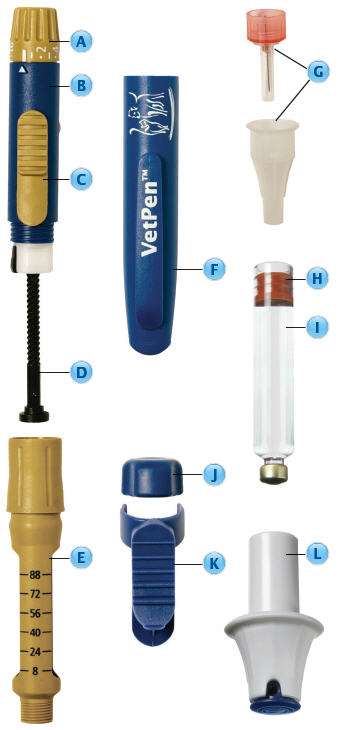
|
|
|
|
Pen Needles
The VetPen™ comes with specially lubricated VetPen™ 29G/12 mm pen needles. Sterility is guaranteed for 5 years from the date of sterilization if the package seal is undamaged. The VetPen™ should be used only with VetPen™ 29G/12 mm pen needles.
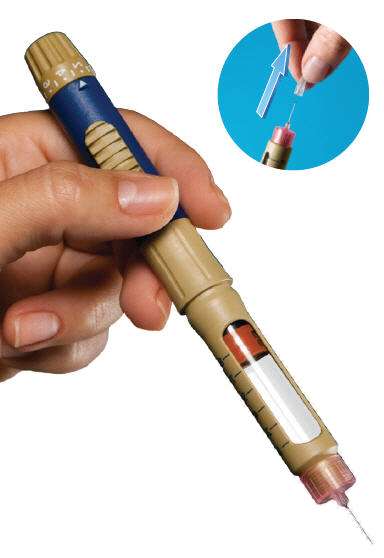
How to Use VetPen™
PLEASE FOLLOW THESE STEP-BY-STEP INSTRUCTIONS CAREFULLY BEFORE USING VETPEN.
Failure to follow these instructions may result in inaccurate dosing of your dog or cat.
Insulin cartridges from any supplier other than Merck Animal Health should not be used with either VetPen™.
Loading a cartridge onto VetPen™
-
① Prior to loading vetsulin® cartridges, shake the cartridge until a homogeneous, uniformly milky suspension is obtained. Clumps or white particles can form in insulin suspensions: do not use the product if visible clumps or white particles persist after shaking. -
② Pull off the VetPen™ cap and unscrew the VetPen™ body from the cartridge holder.

-
③ Check to ensure that the internal plunger is fully retracted. If the internal plunger is not fully retracted, please refer to step 13 to see how to wind the internal plunger back in.
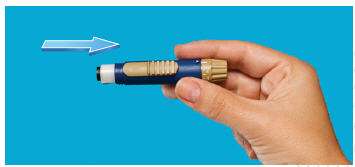
-
④ Load the insulin cartridge into the cartridge holder by inserting the metal cap in first.
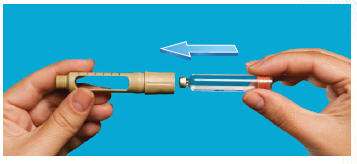
-
⑤ Screw the cartridge holder and VetPen™ body firmly together.

Priming the VetPen™
-
-
⑥ Peel the protective film from a new VetPen™ needle. Screw the VetPen™ needle straight onto the cartridge holder. Remove the outer protective needle cap from the VetPen™ needle.
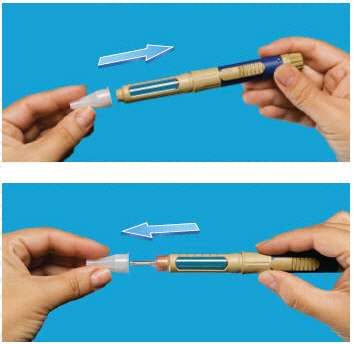
Instructions continued on reverse side. -
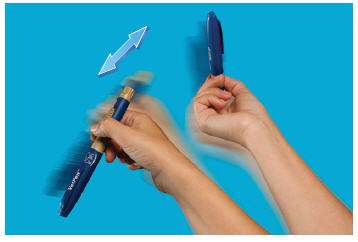
-
⑦ It is important to remove the air from the cartridge (prime) before use to avoid injection of air and ensure proper dosing. Dial one unit on the dose selector. Remove the pen cap.
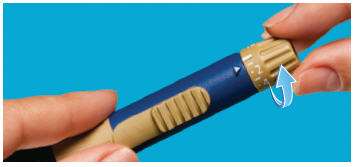
-
⑧ Hold the VetPen™ with the needle pointing up. Tap the cartridge gently with your finger a few times to push any air bubbles to the top of the cartridge. Push and hold the release button towards the needle until the arrow (▶) on the pen body points to the starting line(—) on the dose selector.
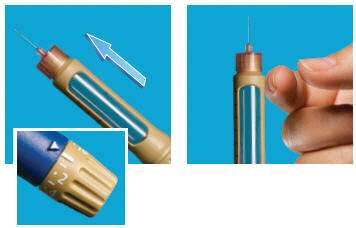
-
If the start line (—) on the dose selector does not return to the arrow (▶) on the VetPen™ body, please refer to the Priming Advice information at the end of these instructions.
Injecting an insulin dose into your dog or cat
-
⑨ Make sure the arrow (▶) on the pen body points to the start line (—) on the dose selector.

The numbers on the cartridge holder can be used as a guide to estimate remaining insulin. If there is not enough insulin, change the cartridge.
Dial up the number of units prescribed by your veterinarian. (The dose shown in this photograph is an example only. Your veterinarian will tell you the recommended dose for your dog or cat.)
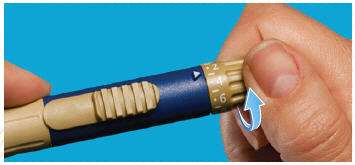
Never attempt to forcefully dial back the dose selector, as doing so may damage the insulin pen and result in inaccurate dosing.
If at any time you overdial the dose, you should fully expel the incorrect dose into a safe place, for example into the sink. Then redial the correct dose prescribed by your veterinarian. Make sure that the arrow (▶) points towards the correct number of units on the dose selector before injecting. -
⑩ The injection should be performed subcutaneously, 2 to 5 cm (3/4 to 2 in) from the dorsal midline, varying from behind the scapulae (shoulder) to the mid-lumbar (mid-back) region and alternating sides. Insert the needle using the injection technique recommended by your veterinarian then push the release button towards the pen needle and hold it in place until the start line on the dose selector returns to the arrow on the pen body (▶ —).
Releasing the button prematurely will result in incomplete delivery of the dose.
After the start line returns to the arrow, wait for a minimum of 5 seconds before removing the needle from the skin.
If the needle is removed or dislodged from the skin too early, you may observe small drops of insulin leaking from the needle, which can result in incomplete dosing. If this occurs, do not attempt to re-dose. Wait and give your dog or cat its usual dose at the next injection.
If the dose selector stops before the start line (—) returns to the arrow (▶), this indicates that your dog or cat has not received a full dose. If only a partial dose is administered, do not attempt to re-dose. Wait and give your dog or cat its usual dose at the next injection.
Removing the needle from the VetPen
-
⑪ Remove the needle by inserting it in the removal device and unscrewing it. Press the blue tip on the removal device to release the needle. Always check that your pen needle has been removed.
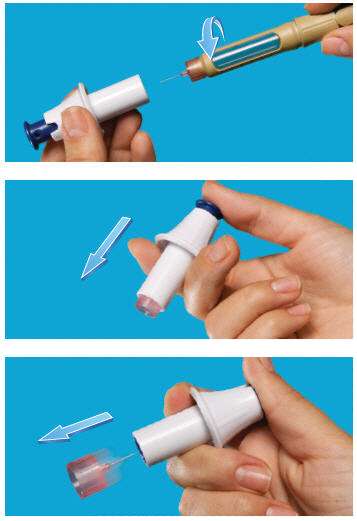
Replace the pen cap onto the insulin pen. Dispose of used pen needles carefully in accordance with the advice given by your veterinarian or local regulations.
Changing the insulin cartridge
-
⑫ Before changing the insulin cartridge, always make sure that the pen needle has been removed to prevent accidental injury. Unscrew the cartridge holder from the pen body and remove the cartridge.
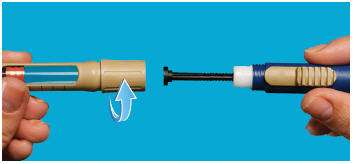
-
⑬ Rewind the internal plunger by holding the white lower part of the pen body between the thumb and finger. Turn the pen body until the internal plunger is fully retracted. Return to step 1 to load the next cartridge.
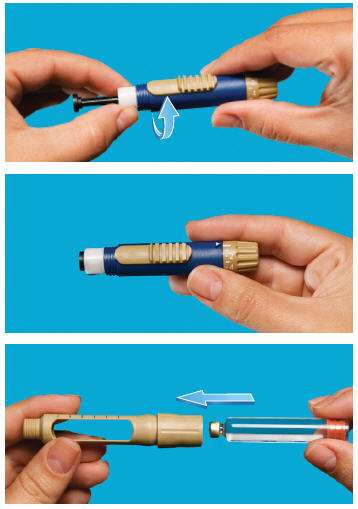
Note: If the internal plunger is rewound incorrectly, it can damage the VetPen™.
Safety Precautions
- VetPen™ should be used only after consultation with your veterinarian.
- VetPen™ should only be used with vetsulin® 2.7 mL cartridges.
- Before each use, ensure that VetPen™ has been primed in accordance with the instructions detailed in steps 7 and 8. Failure to follow the exact priming procedures could result in inaccurate dosing of your dog or cat.
- To avoid potential damage to the VetPen™ , never dial a dose and push the release button without a cartridge in the cartridge holder.
- A new needle should be used for each injection.
- The needle should be removed with the needle remover and safely disposed of immediately after each injection. If the needle is left on the VetPen™ it may become blocked and affect the dose delivered.
- Consult with your veterinarian should you encounter difficulty in injecting your dog or cat or should your dog or cat display any changes in behavior or clinical condition.
- The VetPen™ has been tested to perform accurately for 2 years (2 doses/day) to 4 years (1 dose/day) of use.
Storage and Cleaning
VetPen™ should always be stored or carried with the needle removed, and the pen cap on. To clean VetPen™, wipe with a damp cloth. Do not immerse in water.
Once loaded with a cartridge, the VetPen™ should be stored under refrigeration at 2° to 8°C (36° to 46°F). The loaded VetPen™ can be stored on its side. Do not freeze. Protect from light.
Use contents within 42 days of first puncture.
Contact Information
Merck Animal Health Technical Services: 800-224-5318
www.vetsulin.com
Copyright © 2014 Intervet Inc., a subsidiary of Merck & Co., Inc. All rights reserved.
Priming Advice
If the dose selector does not return to the start line, and no insulin has been expelled, this may indicate one of two possibilities:
- The VetPen™ needle that you are using may be blocked. Remove the VetPen™ needle currently attached to the VetPen™ and replace it with a new one. Then return to steps 7 and 8.
- The cartridge plunger may require releasing. If so:
- Replace the outer protective cap onto the needle.
- Unscrew the cartridge holder.
- Slide the release button towards the internal plunger and hold in place until the start line on the dose selector returns to the arrow on the pen body.
- Dial up 2 units on the dose selector without screwing the internal plunger back together and simply push and hold down the release button towards the internal plunger until the start line on the dose selector returns to the arrow on the pen body.
- Without rewinding the internal plunger, screw the cartridge holder and body firmly together. This will release the cartridge plunger and expel some of the insulin. However, the device will not be primed.
- Holding the device upright, repeat steps 7-8 until the device is fully primed.
Accessories
The following accessories are provided with the VetPen™
- the dose selector adaptor fits onto the dose selector for easier dialing
- the release button extension simply clips onto release button for improved grip
- the needle remover is used to safely remove the pen needle from the cartridge holder after each injection – refer to step 11 for details
PSC020T06 02
76×182mm
C M Y K
133062 R6
AC/1273/11/0363/01
PRINCIPAL DISPLAY PANEL - 10 mL Multi-Dose Vial Carton
vetsulin®
(porcine insulin zinc suspension)
40 units per mL (U-40)
For subcutaneous injection
in dogs and cats only.
CAUTION: Federal law restricts this
drug to use by or on the order of a
licensed veterinarian.
NADA No. 141-236, Approved by FDA
Net contents: 10 mL
MERCK
Animal Health

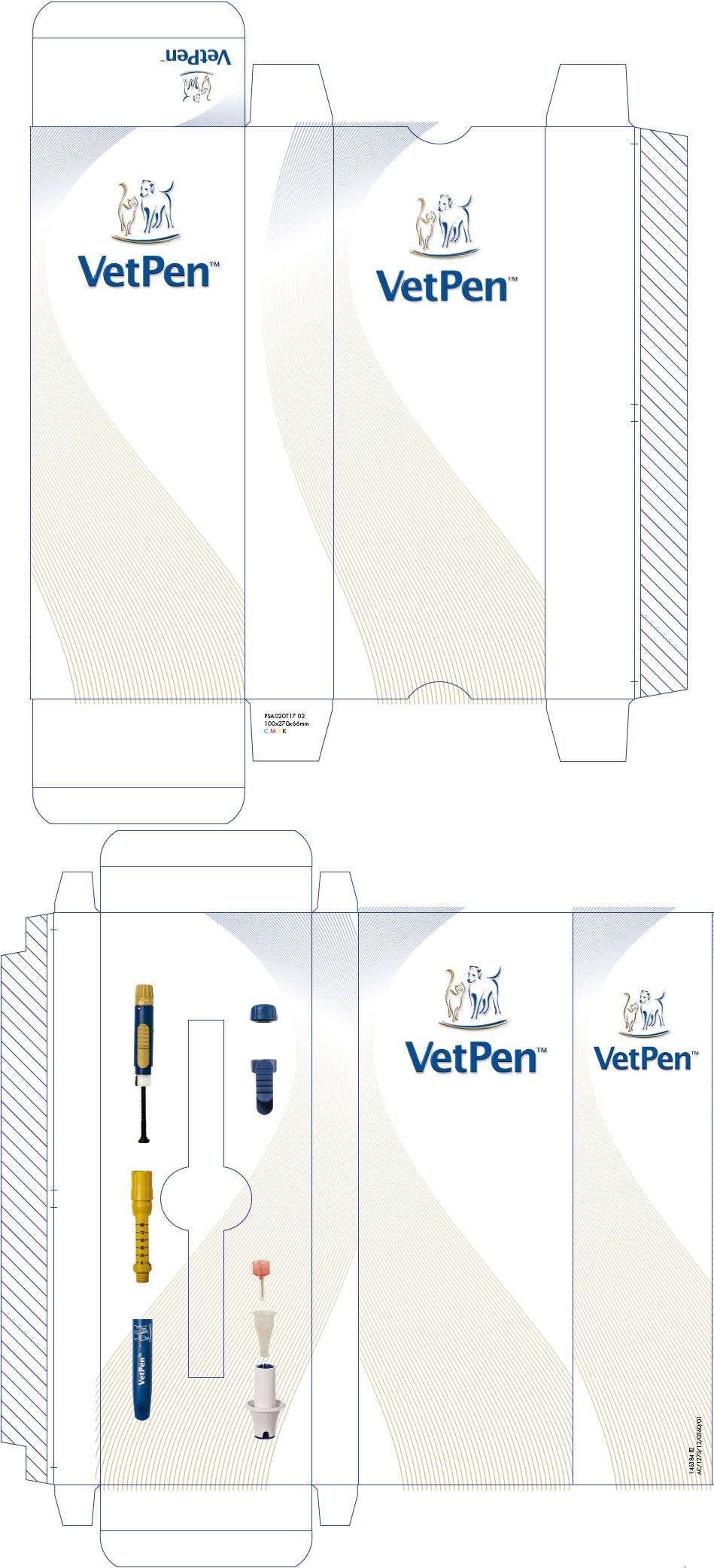
Vetsulininsulin pork INJECTION
| ||||||||||||||||||||||||||||||||||||||||||||||||||||||||||||||||||||||||||